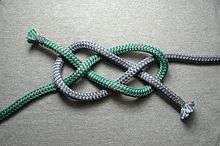Chinese button knot
| Doubled Chinese button knot, flat and tightened in the same picture | |
|---|---|
|
| |
| Category | Decorative |
| Category #2 | Stopper |
| Related | diamond knot, Celtic button knot |
| Typical use | clothing button |
| ABoK | #599 |
Chinese button knot is essentially a diamond knot where the lanyard loop is shortened to a minimum, i.e. tightened to the knot itself. There emerges therefore only two lines next to each other from the knot: the beginning and the end. The knot has traditionally been used as a button on clothes in Asia, thus the name.
Tying
The diamond knot is usually tied with a carrick bend as a first step. This results then in a knife lanyard knot which can be used as a button hole, as well as a button.
 Tying starts with a diagonal carrick bend
Tying starts with a diagonal carrick bend Ends continue around and under the standing part on the other side
Ends continue around and under the standing part on the other side Ends up through the middle hole
Ends up through the middle hole Tightened
Tightened
There is however a tying method that does not require a carrick bend as a first step, and does not produce a lanyard loop that needs to be reduced when used as a button. This method provides just the button, a spherical basket weave knot, in the style of Turk's head knot or diamond knot.
Instructions for tying Chinese button knot in single configuration using this method as illustrated in the adjacent image, with 4 steps in tying it; thin red lines showing the move(s) to get to the next step :

- - Under hand slip knot, with slip-end exiting upwards to the right.
- - Slip-end leftwards over the knot, under and up through the slip loop, resulting in two interlocking slip knots in radial symmetry, with ends exiting upwards.
- - Ends down the opposite triangular holes at center, while swirling slightly around each other resulting in a four petaled flower with double stem,
- - For a several strand Chinese button knot one end follows consistently along the in- or out- side of the other stem back to the same point after having traversed all four petals.
- - Tightened to an evenly spherical button.